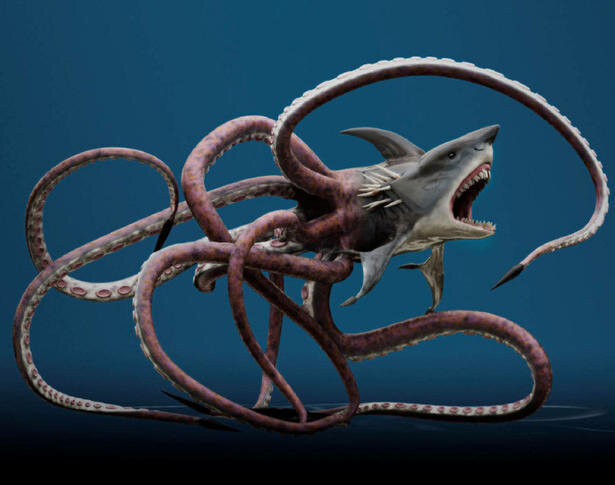Sharktopus

The Sharktopus is a creature that existed well before the fall of the Ancients. In their infinite wisdom, the Ancients were always looking for new biological weapons. They decided that crossing the genetic code of a great white shark with that of an octopus would be a good idea.
In some aspects, it was. They did indeed manage to create a new life form, one that was incredibly dangerous. But as was usually the case, they found that they couldn’t control the creature.
Chris Van Deelen is the author of the Skirmisher Publishing LLC sourcebook Creatures of the Tropical Wastes sourcebook, co-author of its Wisdom from the Wastelands game supplement and contributor to the 'Sword of Kos: Hekaton' Anthology.
No. Enc: 1
Alignment: Neutral
Movement: 180’ (60’) Swim
AC: 2
HD: 30
Attacks: 1 bite or 8 tentacles or 1 ram
Damage: 5d6 or 2d8 x8 or 6d6
Save: L20
Morale: 7
Hoard Class: None
The Sharktopus is a creature that existed well before the fall of the Ancients. In their infinite wisdom, the Ancients were always looking for new biological weapons. They decided that crossing the genetic code of a great white shark with that of an octopus would be a good idea.
In some aspects, it was. They did indeed manage to create a new life form, one that was incredibly dangerous. But as was usually the case, they found that they couldn’t control the creature.
To make matters worse, it not only escaped into the wilds of the oceans, but multiplied and thrived to the point that it began to eat the other predators of the deep, and as a result began to unbalance the oceans natural order. Of course final wars which almost destroyed the Ancients took care of that and in a sense, restored balance.
These creatures are massive, being over thirty feet in length from the tip of their nose to the end of their body where the tentacles begin, and they weigh in excess of ten tons each. The Tentacles themselves are twenty feet in length and are each tipped with a nearly metal hard piece of cartilage that they can use like a spear. These creatures thankfully, are solitary and are even prone to attack their own kind except when they are mating.
In combat, the creatures have several attacks open to them. As with their ancestors, they prefer to bite their prey, but they can also use all eight of their tentacles to grab and pull prey to them, or simply impale the prey on the tentacles and bring them to their mouths that way. Finally, due to the not only the sandpaper-like quality of their skin, but the large number of spikes that grow from the side and back, just past the gills before the beginning of the tentacles, they can ram creatures for great effect.
If the genetically engineered monstrosity rolls a natural 18-20 on a bite attack, any human sized creature will be swallowed whole. Any creature thus swallowed will take 3d6 damage per turn due to the powerful digestive acids in the creature’s stomach. These acids are so powerful that they will even corrode the heaviest of alloy. The only way for a swallowed victim to escape is by killing the creature, or by cutting its way out. The interior of the mutant’s stomach is very tough (AC 2) and a victim must do at least 25% of the creatures total hit points to cut itself free.
Any creature grabbed by the tentacle can attempt to free themselves, but it will be either a grapple check (if the Mutant Lord is using such a system or see Wisdom from the Wastelands issue 11: Optional Combat rules) or strength versus strength check (with the mutant having strength of 30). The creature then can either bring the creature to its mouth to bite, with the mutant creature getting a +4 to its bite attack or it can inflict its 2d8 points of constricting damage per round.
If the creature is threatened or takes enough damage, it can spew out a thick black cloud if acidic ink. This cloud will fill an area of up to 50’ in diameter and anything caught in the cloud will suffer 2d6 points of acid damage per round.
These creatures mate only once every 5 years and it is a quick and usually violent affair. The monstrosities fight each other for several rounds, inflicting as much damage as they can. If the male inflicts more damage on the female, she will mate with him and then leave.
The female gestates the eggs inside her body for ten months and then deposits 1d100 of the eggs (which are six inches in diameter and weight one pound) in a natural underwater cavern, coral reef or even a ruin or sunken vessel.
She then guards the egg cluster for another six months as the pups develop. When they finally hatch, the pups go into a feeding frenzy, attacking each other until only 1d6 are left, the strongest ones. At this point, they leave the area as quickly as they can and stake out their own territories.
Mutations: Aberrant form (natural weapons, xenomorphism: chimera), gigantism, heightened sense (smell, taste), spiny growth, toxic weapon (acidic ink cloud).
Source: Sharktopus (2010)